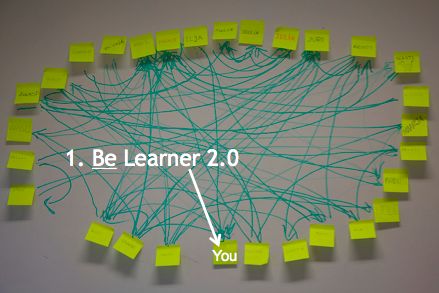One of the areas we are focusing on more as we progress into the new year is helping our clients with sourcing talent for their learning initiatives. We’ll be offering a variety of resources in the coming months, but as I am currently in the midst of preparing to speak to a group of professional society educational leaders, I thought it would good to outline what I see as some essential skills and tactics for leading in the world of the learning economy and Learning 2.0.
Here they are:
1. Be the Learner You Seek
I always come back to this one as foundational. If you want to implement new approaches to learning with your membership and customer base, you need to be experienced in these new approaches yourself. Indeed, I’d argue you need to be deeply immersed in them.
This means taking advantage of social platforms for your own learning and growth – and with an eye towards understanding how these tools might be of most value to your learners. (See Learning 2.0 for Associations for a variety of suggestions and examples.)
It means trying out a variety of new tools for creating and distributing learning content.
It means actively participating in lifelong learning experiences from a variety of sources, including competitors, and trying out learning and business models that take you out of your comfort zone.
It means being conversant in the vastly increased knowledge we now have about how people learn and the challenges that adult learners may encounter in the new world of learning.
Learning leaders continually explore and experiment.
2. Tend Your Home Fires
I lot of organizations rush off to participate in social networks without ensuring that their home base, their Web site, is a usable, inviting source of knowledge and learning value.
Worse yet, many put links to social networks front and center on their Web sites, thus inviting to users to leave and find value in places where the organization has significantly less control.
Now, don’t get me wrong: social networks can be leveraged to great benefit, and “control” is elusive and often not desirable in good adult learning environments. Nonetheless, you need a strong home base that is yours if you expect learners to identify deeply with your organization and the value it provides. Also, there is no telling what Facebook or LinkedIn may do someday, but you can determine the future of your own site.
Your Web site should offer a wealth of content – articles, blog posts, podcasts, videos, etc. I advocate as much of this as possible being freed up from behind the member login so that it can generate search results for you and demonstrate your value to prospective members.
What’s more, your Web site should feel like the hub of a learning community. It should feel human. This means simple things like lots of pictures and videos featuring members as well as extensive use of testimonials, stories, and case studies. I am always surprised how little I tend to see of this on the average membership Web site.
Learning leaders understand what it takes to make their organization’s Web site a true asset.
3. Know and Manage Your Value Ramp
This point is directly related to the previous one, but I think merits being broken out on its own. I won’t go into great detail here because we’ve written about the Value Ramp in a number of places.
The basic idea, though, is that you provide value to your stakeholders along a curve that descends from an area on the lower right, where there are few, if any, barriers to access, to an area on the upper left, where barriers – including price – are significantly higher and access to you and your offerings are highly distinctive or even unique.
At the heart of the Value Ramp is the idea that your customers vary great with respect to their needs and the level of trust that they place in you. Thus, it pays to serve them in a variety of ways, but many organizations focus nearly all their efforts around the middle of the curve..
I encourage you to read my post about ways to fill out the curve and build momentum along it.
Learning leaders understand the lessons of the Value Ramp and provide value in multiple ways.
4. Leverage Listening
I was delighted when a client told me recently that he had been watching conversation around a topic grow rapidly on one of the organization’s listserves and decided as a result to launch a Webinar on the topic. The Webinar, as you might expect, was a success.
This is the kind of “listening” that is now possible as a result of the tools that the Web provide, and it can be a powerful source of ideas to serve your market as effectively as possible.
In addition to monitoring any e-mail lists or forums offered by your organizations (including ones you set up on social networks), you can also listen more broadly across the Web and a variety of networks by taking advantage of free or low cost tools.
I have used Feedly for years. A bit more recently, I have come to rely increasingly on the growing set of tools that HootSuite provides for monitoring and interacting with Twitter, Facebook, LinkedIn and a variety of other sources.
The tools available in this area change rapidly, but a good source for keeping up with them is Beth Kanter’s list at https://socialmedia-listening.wikispaces.com/Tools.
Learning leaders know how to leverage listening tools to understand and serve their markets.
***
You can read part II of this post at https://www.tagoras.com/leading-learning-skills-tactics-2/


Leave a Reply